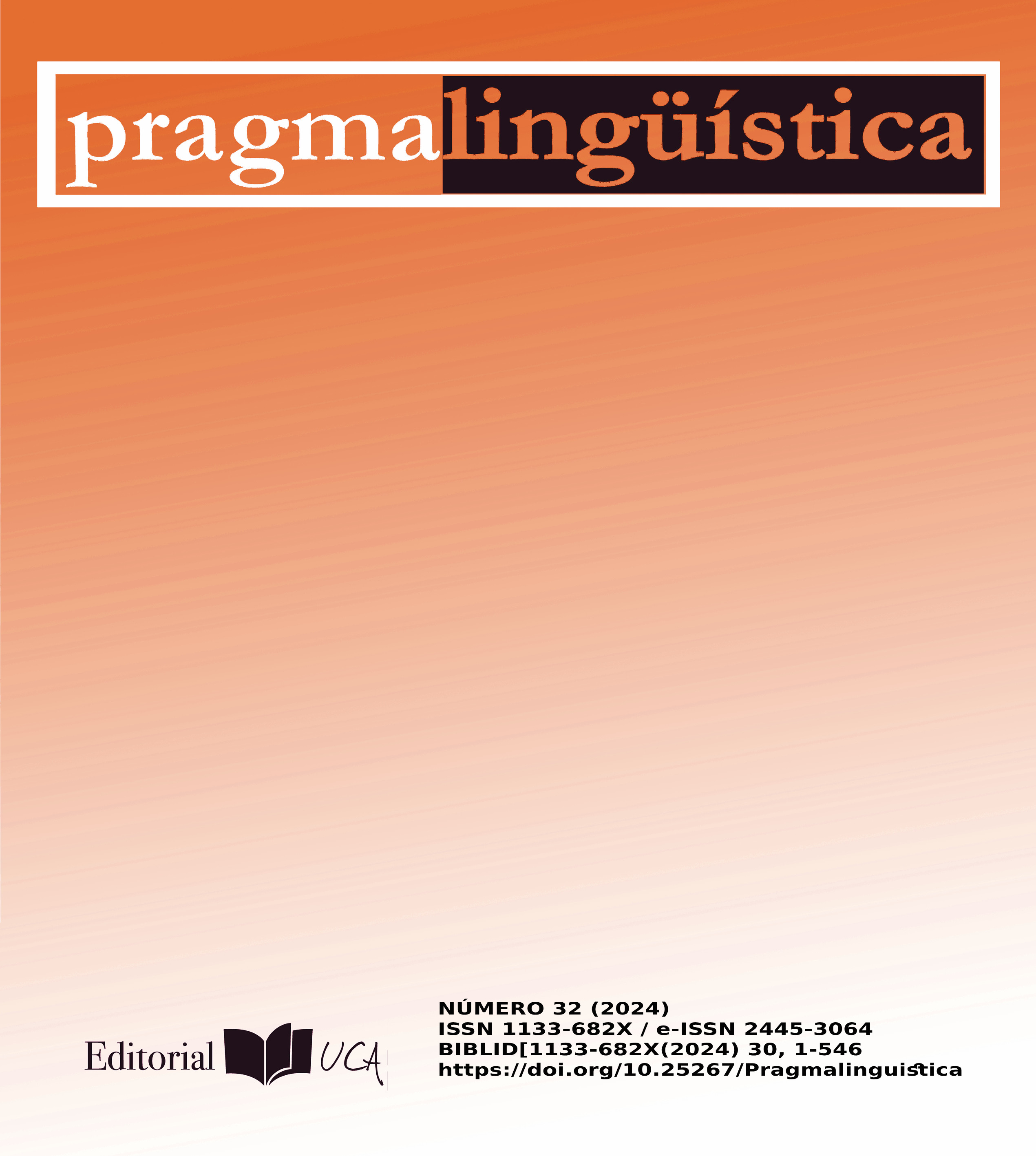Reseña de Traugott (2022), Elizabeth Closs, Discourse Structuring Markers in English. A historical constructionalist perspective on pragmatics

DOI
https://doi.org/10.25267/Pragmalinguistica.2024.i32.20Info
Téléchargements
Comment citer
Licence
(c) Tous droits réservés Emma Álvarez Prendes 2024

Ce travail est disponible sous licence Creative Commons Attribution - Pas d'Utilisation Commerciale - Pas de Modification 4.0 International.
Références
BRINTON, L. J. (2008): The comment clause in English: Syntactic origins and pragmatic development, Cambrige: Cambridge University Press.
CROFT, W. (2001): Radical Construction Grammar: Syntactic theory in typological perspective, Oxford: Oxford University Press. https://doi.org/10.1093/acprof:oso/9780198299554.001.0001
DETGES, U. y WALTEREIT, R. (2002): “Grammaticalization vs. reanalysis. A semantic pragmatic account of functional change in language”, Zeitschrift für Sprachwissenschaft, 21, pp. 151-195. https://doi.org/10.1515/zfsw.2002.21.2.151
ERMAN, B. y KOTSINAS, U.-B. (1993): “Pragmaticalization: The case of ba’ and you know”, Studier i Modernspråkvetenskap, 10, pp. 76-93.
FRASER, B. (1996): “Pragmatic Markers”, Pragmatics, 6, pp. 167-190. https://doi.org/10.1075/prag.6.2.03fra
FRASER, B. (2009): “Topic orientation markers”, Journal of Pragmatics, 41(5), pp. 892-898. https://doi.org/10.1016/j.pragma.2008.08.006
GOLDBERG, A. E. (1995): Constructions: A Construction Grammar Approach to Argument Structure, Chicago: University of Chicago Press.
GOLDBERG, A. E. (2006): Constructions at work: The nature of generalization in language, Oxford: Oxford University Press.
HANSEN, M.-B. M. (2012): “The semantic of pragmatic expressions”, Schmid¸ H.-J. (ed.), Cognitive Pragmatics, Berlín: De Gruyter Mouton, pp. 589-613.
HEINE, B. y LONG, H. (2022): “Review of Traugott (2022): Discourse structuring markers in English: A historical constructionalist perspective on pragmatics”, Functions of Language, 29 (3), pp. 338-343. https://doi.org/10.1075/fol.00045.hei
HEINE, B., CLAUDI, U. y HÜNNEMEYER, F. (1991): Grammaticalization: A conceptual framework, Chicago: University of Chicago Press.
HEINE, B., KALTENBÖCK, G., KUTEVA, T. y LONG, H. (2017): “Cooptation as a discourse strategy”, Linguistics, 55(4), pp. 813-855. https://doi.org/10.1515/ling-2017-0012
HEINE, B., KALTENBÖCK, G., KUTEVA, T. y LONG, H. (2021): The rise of Discourse Markers, Cambridge: Cambridge University Press. https://doi.org/10.1017/9781108982856
LANGACKER, R. W. (1990): “Subjectification”, Cognitive Linguistics, 1, pp. 5-38. https://doi.org/10.1515/cogl.1990.1.1.5
SCHWENTER, S. A. y WALTEREIT, R. (2010): “Presupposition Accommodation and language change: From additivity to speech-act marking”, Davidse, K. Vandelanotte, L. y Cuyckens, H. (eds.), Subjectification, intersubjectification and grammaticalization, Berlín: De Gruyter Mouton, pp. 75-102. http://dx.doi.org/10.1515/9783110226102.2.75
SMIRNOVA, E. y SOMMERER, L. (2020): “The nature of the node and the network – Open questions in Diachronic Construction Grammar”, Sommerer, I y Smirnova, E. (eds.), Nodes and networks in Diachronic Construction Grammar, Amsterdam/Philadelphia: John Benjamins, pp. 1-42. https://doi.org/10.1075/cal.27
TRAUGOTT, E. C. (1997 [1995]), “The role of the development of discourse markers in a theory of grammaticalization”, paper presented at ICHL XII, Manchester 1995.
TRAUGOTT, E. C. y DASHER, R. B. (2002): Regularity in semantic change, Cambridge: Cambridge University Press. https://doi.org/10.1017/CBO9780511486500
TRAUGOTT, E. C. y TROUSDALE, G. (2013): Constructionalization and constructional changes, Oxford: Oxford University Press.
TROUSDALE, G. y TRAUGOTT, E. C. (2021): “Rethinking constructionalization: the history of by the way”, paper presented at ISLE 6, Joensuu.
VERHAGEN, A. (1995): “Subjectification, syntax, and communication”, Stein, D. y Wright, S. (eds.), Subjectivity and Subjectivisation in Language, Cambridge: Cambridge University Press, pp. 103-128.





